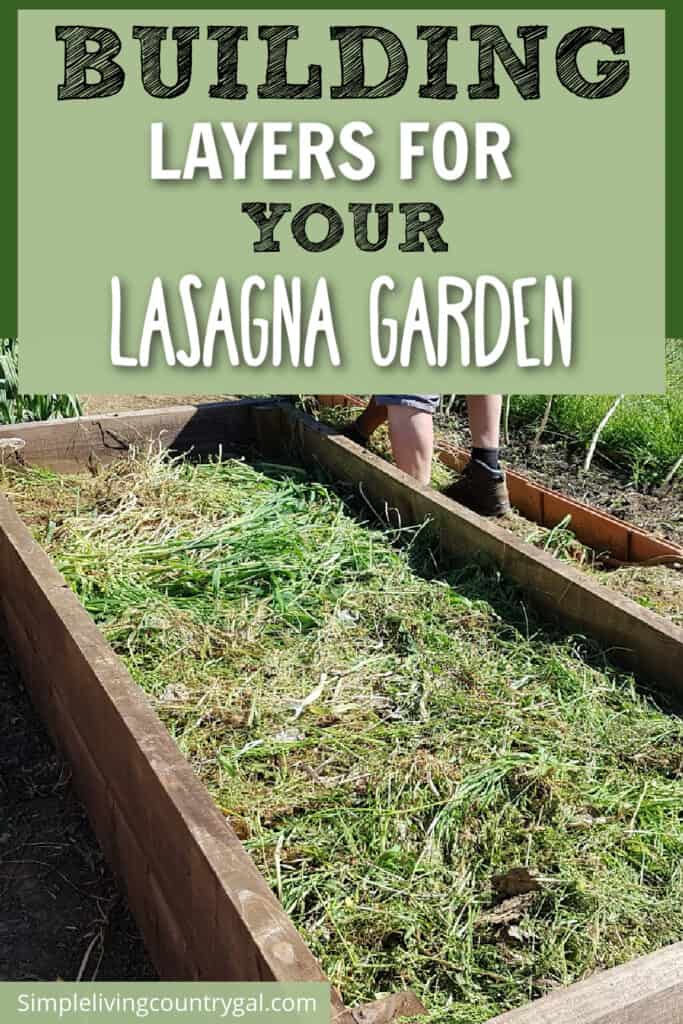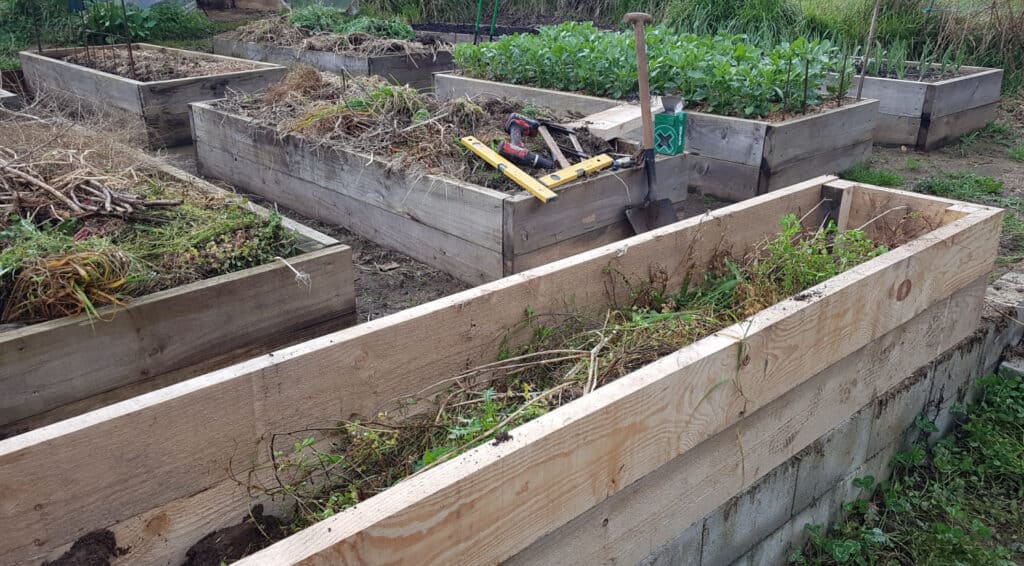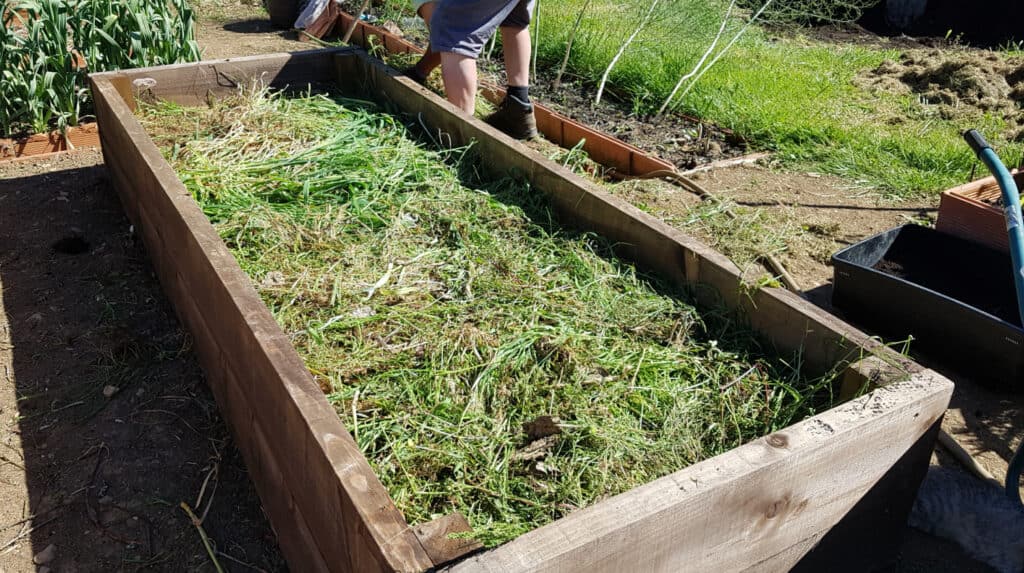Lasagna Gardening Layers
Finding easier ways to grow your food is always a goal of mine. Lasagna gardening is a great way to jumpstart a new growing area more easily. This article on how to set up lasagna gardening layers to create a healthy base for your new vegetable garden will help you know what goes where and why.
I love this unique gardening 101 approach to turning less than optimal soil into a thriving backyard garden.

I love having a homestead. Being in control of the food our family eats is the biggest reason why. Over the years I have needed to change how I do certain projects. This includes finding easier ways to setup new areas for our garden that doesn’t require hard back breaking work. Lasagna gardening is the perfect solution if you are looking for a shortcut approach to expanding your backyard garden.
What is lasagna gardening?
Lasagna gardening is when you layer different materials on top of the ground as you would in a compost bin. The layers break down over time, giving you a nutrient rich material that is perfect for plants to grow in all without having to remove any sod or compacted soil.
Each layer has a specific job to do and knowing the role they play will better help you to put them in the best order. This style of gardening is also known as sheet composting.

Why use lasagna gardening?
There are many benefits to using lasagna gardening, including:
- No tilling or digging is needed: Unlike traditional gardening methods, there is no need to remove the sod or dig up the soil. This makes it easier on your back, shoulders, and knees.
- Improves poor soil: Lasagna gardening is perfect for anyone with poor soil quality. The layers of organic materials will help improve soil structure by adding nutrients. It also adds air to the soil, improving drainage.
- Saves money: You can often find many materials needed for lasagna gardening for free. This makes it an affordable option for creating a new garden bed.
- Eco-friendly: Since the layers are mainly recycled materials such as cardboard, newspaper, and kitchen scraps, this is known as an eco-friendly option.
- Low maintenance: Once the layers are in place, it requires minimal maintenance from there. The layers of organic materials will continue to break down and provide nutrients for your plants.
Be sure to grab your FREE New Garden Setup Checklist below!!
Lasagna Gardening Layers
The layers in lasagna gardening are what makes this method so effective. Each layer serves a specific purpose, as it would in a compost bin. There are five layers, and each works together to create a healthy and nutrient-rich soil.
1. Cardboard or newspaper
It is best to begin with a thick layer of newspaper or cardboard. This will serve as a barrier between the ground and the new garden bed. The bottom layer is a barrier that will keep any grass or weeds from growing up among your plants.
2. Brown materials
Brown materials are your carbon-rich layers. These include dried leaves, twigs, straw, pine needles, or wood ash. These materials act like sponges, absorbing excess moisture and providing air pockets for the roots to grow.
3. Green materials
The next layer is made up of nitrogen-rich materials such as grass clippings, vegetable scraps, egg shells, and coffee grounds. These materials will help to activate the decomposition process and provide essential nutrients for your plants.
4. Compost
Adding a layer of compost helps to speed up the breakdown of materials and provides even more nutrients for your plants.
5. Soil or topsoil
The final layer is a thin layer of soil or topsoil. This layer will act as a base for your plants and help to retain moisture.

When is the best time to start a lasagna garden?
The best time to start a lasagna garden is in the fall so it can work it’s magic throughout the winter months. This will give enough time for the layers to break down over the winter so it is ready for planting in the spring.
Can you do a lasagna garden in the spring?
Even though it is best to start this style of garden in the fall you can still set one up in the spring. Once you have your layers in place, top with a thick layer of soil. This will give you enough room to plant your seeds and seedlings. As the roots grow deeper, the layers will have time to begin breaking down, allowing your plants to grow as they normally would.
Easier Gardening Tools:
Gardening Hand Tool Set 3 Pack – MDSXO Heavy Duty Gardening Kit with Non-Slip Soft Ergonomic Handle, Great Garden Gift for Women Men[Stainless Steel]![Gardening Hand Tool Set 3 Pack - MDSXO Heavy Duty Gardening Kit with Non-Slip Soft Ergonomic Handle, Great Garden Gift for Women Men[Stainless Steel]](https://easyproductdisplays.com/wp-content/uploads/2017/07/buy6.gif)



Additional Tips for Lasagna Gardening
When using this approach to gardening, keep a few tips in mind. These tips will help ensure the layers’ composting does its job more effectively.
- Water well: After constructing your lasagna garden, water it well to help the layers settle and begin the composting process. Keep in mind you want to water and not drown the layers.
- Choose the right plants: Lasagna gardening is perfect for growing many different plants, but some do better than others. Plants like squash, pumpkins, tomatoes, and peppers are all great options to grow.
- Maintain moisture: While the layers in lasagna gardening help to retain moisture, you may still need to water your plants regularly, especially during hot and dry periods. Always check the soil for dampness to determine when and how much to water. A good rule of thumb is, an inch of water per week, but you can get tips on how to water your garden here for more help.
- Add a mulch layer: Applying a layer of mulch on top will help to deter weeds as well as regulate soil temperature. Read even more benefits of mulching your garden.
- Rotate crops: To prevent nutrient depletion in the soil, rotate your crops each season. This is a tip I learned years ago and one that greatly improved the health of our soil. You can get more tips on rotating your garden crops and how to track for easier movement.
- Monitor for pests and diseases: No matter what style of garden you set up, you will always want to watch for signs of pests or diseases. Practice natural pest control methods, like vegetable companion planting to keep your garden healthy.
I love lasagna gardening and how well it works to jumpstart a new bed for our backyard set up. I like to call this the lazy girl’s way of gardening and I know you will love it as much as I do.
All you need is a pile of newspaper, some compost, grass clippings, and kitchen scraps, and before you know it, you will have a brand-new vegetable garden in your backyard. Bookmark this article on lasagna gardening layers so you can read it anytime you are ready to start a new area.

![Gardening Hand Tool Set 3 Pack - MDSXO Heavy Duty Gardening Kit with Non-Slip Soft Ergonomic Handle, Great Garden Gift for Women Men[Stainless Steel]](https://m.media-amazon.com/images/I/41qgPIFVlJL._SL500_.jpg)



